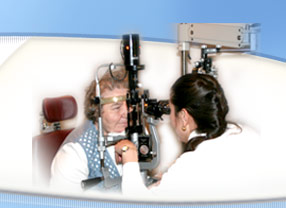
| Read About Other Additional Eye
|
What is Glaucoma?
Glaucoma is a group of diseases that can lead to damage to the eye's Optic nerve and result in blindness.
Open-angle glaucoma, the most common form of glaucoma, affects about 3 millon Americans-half of whom don't know they have it. It has no symptoms at first. But over the years it can steal your sight. With early treatment, you can often protect your eyes against serious vision loss and blindness.
What is the optic nerve?
The optic nerve is a bundle of more than 1 million nerve fibers. It connects the retina, the light -sensitive layer of tissue at the back of the eye, with the brain. A healthy optic nerve is necessary for good vision.
How does glaucoma damage the optic nerve?
In many people, increased pressure inside the eye causes glaucoma. In the front of the eye is a space called the anterior chamber. A clear fluid flows continuously in and out of this space and nourishes nearby tissues.
The fluid leaves the anterior chamber at the angle where the cornea and iris meet. When the fluid reaches the angle, it flows through a spongy meshwork, like a drain, and leaves the eye.
Open-angle glaucoma gets its name because the angle that allows fluid to drain out of the anterior chamber is open. However, for unknown reasons, the fluid passes too slowly through the meshwork drain. As the fluid builds up, the pressure inside the eye rises. Unless the pressure at the front of the eye is controlled, it can damage the optic nerve and cause vision loss.
Who is at risk?
Although anyone can get glaucoma, some people are at higher risk than others. They include:
Everyone over age 60.
African Americans over age 40. People with diabetes. People with a family history of glaucoma.
What are the symptoms of glaucoma?
At first, open-angle glaucoma has no symptoms. Vision stays normal and there is no pain. As glaucoma remains untreated, people may notice that although they see things clearly in front of them, they miss objects to the side and out of the corner of their eye.
Without treatment, people with glaucoma may find that they suddenly have no side vision. It may seem as though they are looking through a tunnel. Over time, the remaining forward vision may decrease until there is no vision left.
How is glaucoma detected?
To detect glaucoma, your eye doctor will check visual acuity, visual fields, dilate your pupils, and perform tonometry, which determines the pressure inside the eye.
![]()